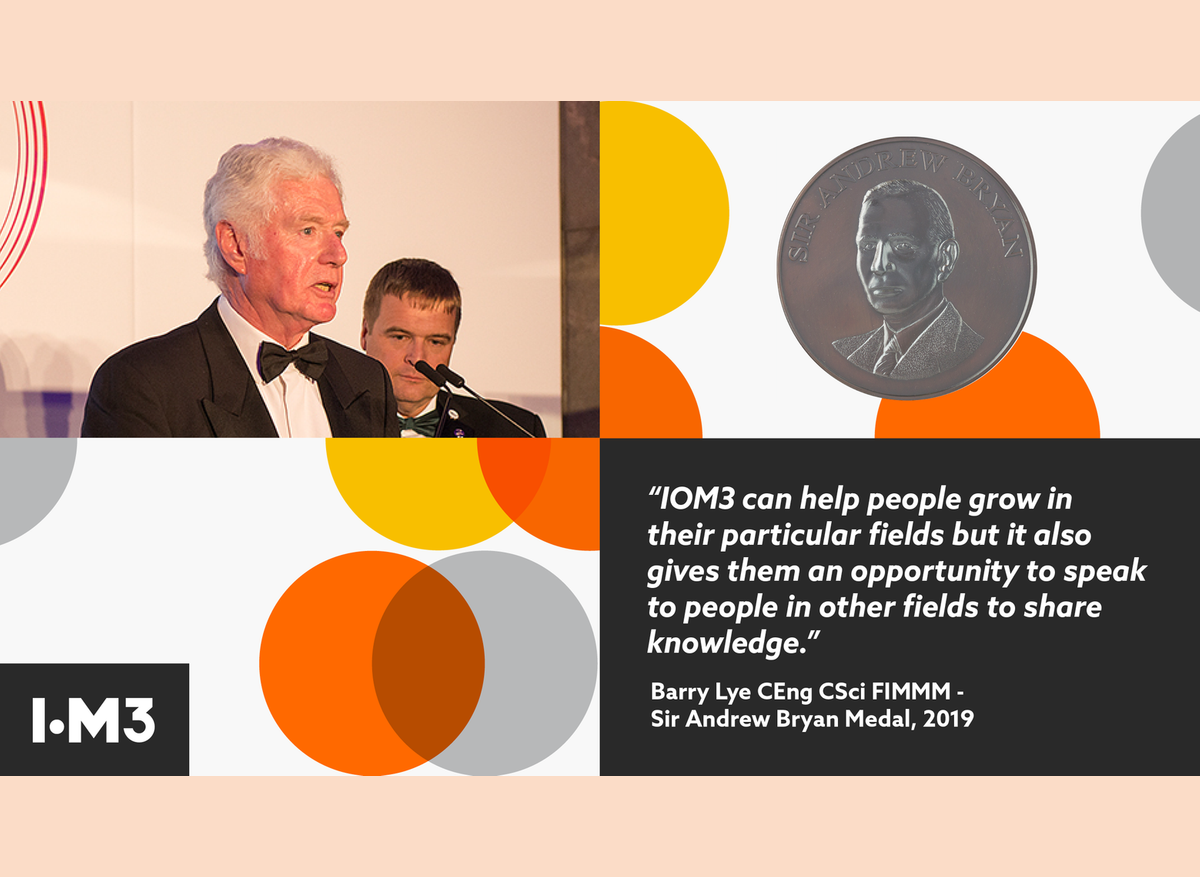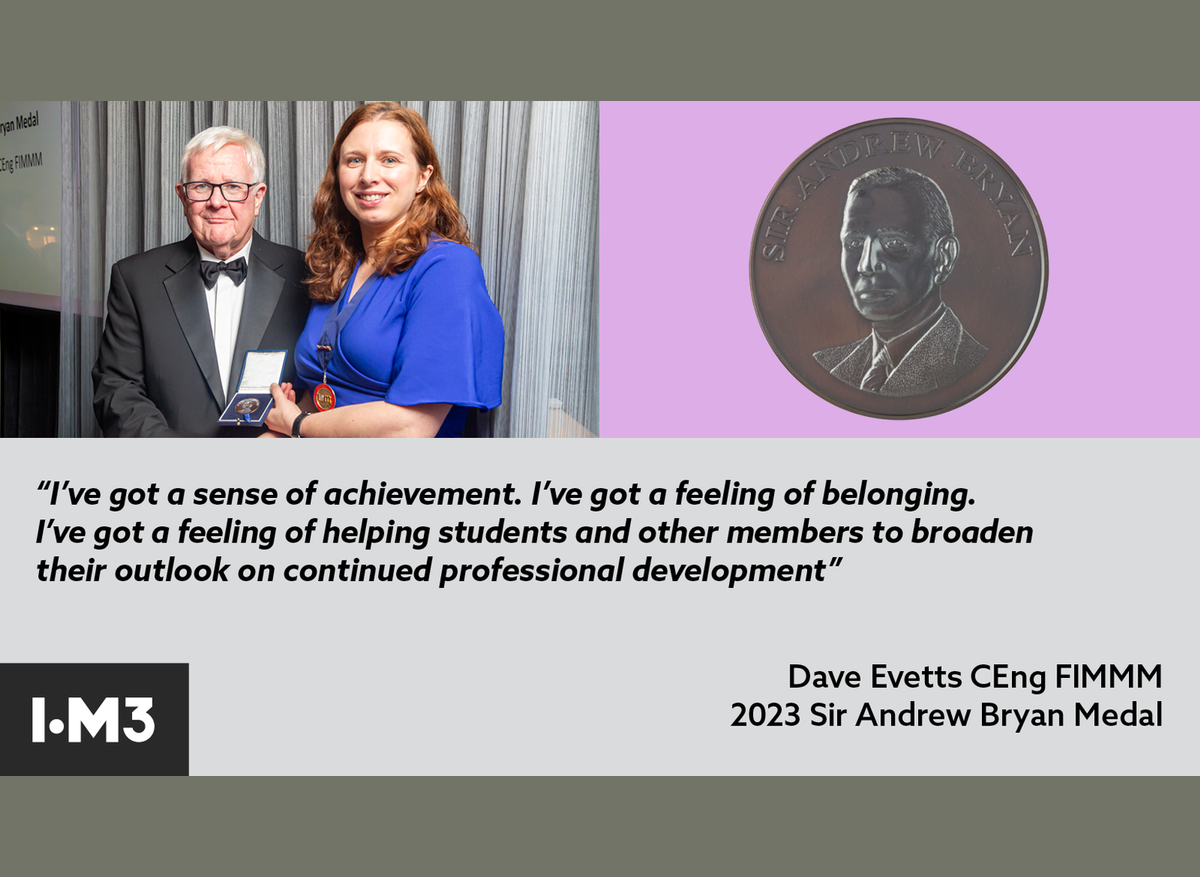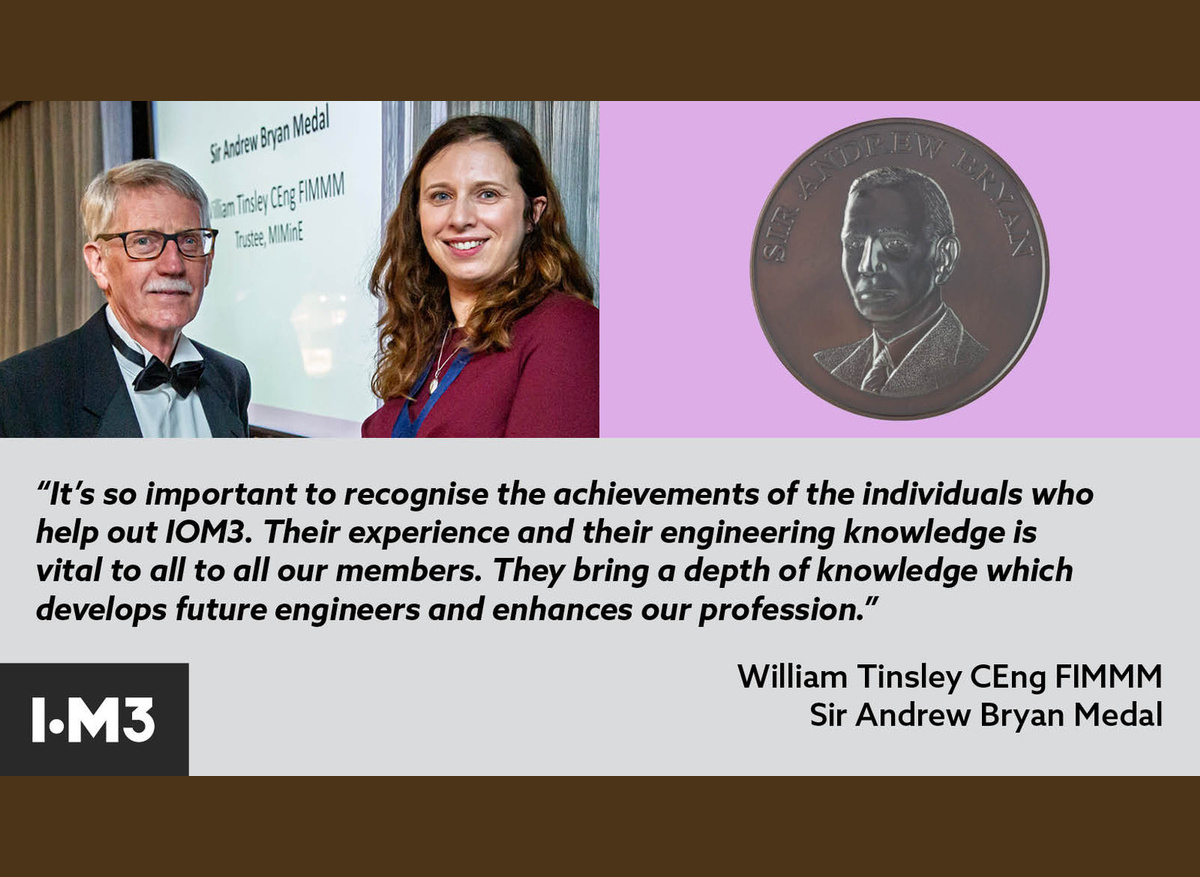Sir Andrew Bryan Medal
For significant contribution to the Institute, through an Affiliated Local Society and/or to the IOM3 Local Affairs Committee over a sustained period of time.
The winner will receive a medal.
Award judging
Past winners
2021 -
2024 William Tinsley CEng FIMMM, 2023 David Evetts CEng FIMMM, 2022 Dr Phil J E Bischler CEng CSci FIMMM, 2021 Stuart Patrick FIMMM
2001 - 2020
2020 Keith Harrison FIMMM, 2019 Barry D Lye Dr Phil Bischler CEng CSci FIMMM, 2018 Andrew Raine CEng FIMMM, 2017 Norman Jackson CEng FIMMM, 2016 Guy Bridges CEng FIMMM, 2015 Jan C H Lewis CEng CEnv FIMMM, 2014 David Seath CEng FIMMM, 2013 Chris Hallas CSci FIMMM, 2012 Stephen Pye FIMMM, 2011 Norman Riley IEng HonFIMMM, 2010 Chris Corti CEng CSci FIMMM, 2009 Prof Andrew Strang CEng FIMMM, 2008 Prof Roger Whatmore FREng CEng FIMMM, 2007 John Weston CEng FIMMM, 2006 J Harris, 2001 Charles T Massey OBE FREng CEng HonFIMMM, Brendan J Breen CSci & H E K Allen
1972 - 2000
1999 Dr John V Bramley FREng CEng FIMMM & John C H Longden FREng CEng FIMMM, 1989/90 Prof Jonathan F Tunnicliffe FREng CEng, 1988/89 P I Allsop, 1983/84 G R Strong, 1982/1983 F B Hinsley, 1981/82 H J King CBE, 1980/81 W J W Bourne, 1975/1976 J Brass CBE, 1973/74 S W Potts OBE, 1972/73 Sir Andrew Bryan
About Sir Andrew Meilke Bryan HonFIMinE
Sir Andrew Bryan passed away peacefully on Monday, 27 June 1988 after a lifetime dedicated to the mining industry. He was the son of Baillie John Bryan of Burnbank, Hamilton, Lanarkshire, being born on 1 March 1983.
It was here, in 1907 that he commenced work on the colliery screening plant and almost immediately, took an intense interest in mining as a profession. In a very short time he was working underground and attending evening classes at Hamilton Technical College, In 1911 he was presented with the Dixon Prizeman prize at the College and was awarded a book to mark the occasion. This book, with the inscription, remained one of his most treasured possessions all his life. The following year, he was called to service in the OTC and the armed forces, serving in the Artists Rifles. In 1919 at the end of hostilities he graduated from the University with a Special Distinction in BSc (Mining) and in the same year, obtained his First Class Certificate of Competency in mine management. With these prime qualifications in hand, Sir Andrew set about obtaining mining experience in the Lanarkshire Coalfield and in 1926 started on the lower rung of his career as HM Junior Inspector of Mines. After sic years in this post he became a Senior Inspector.
Between 1932 and 1940, while still in his thirties, he had the unique distinction of holding the dual appointment of Dixon Professor of Mining at Glasgow University and at the Royal Technical College. During his academic life, Sir Andrew continued his involvement in the professional field, having joined the Mining Institute of Scotland in 1910 as a student member, and the National Association of Colliery Managers in 1919. He was awarded the Gold Medal from the latter organisation for his published contributions.
In 1938 he reported on St Georges Coalfield, Newfoundland, for HM Colonial Office, and between 1939 and 1949 was seconded to the Ministry of Fuel and Power as Deputy Director for Mining Supplies. Over seven years of academic life seemingly enhanced his usefulness to industry, for in 1949, he was selected for the eminently practical job of General Manager of the Shotts Iron Company and by 1942m rapidly stepped up to the post of Managing Director. He was also a Director of the Association of Lothian Coal Owners Ltd. At that time it was said that to a man like Sir Andrew, there was nothing strange in the alternation between the professor's chair and the pit shaft, for his working days always proclaimed his insistence on the urgent need to correlate scientific theory and the everyday practice of mining.
Continuing his professional involvement, Sir Andrew served as President of the National Association of Colliery Managers, Scottish Branch, for the years 1942-44.
In 1943, he was once more called to help the country's war effort in his appointment to the Ministry of Fuel and Power as Group Production Director in the Scottish Region. In the same vein, he served from 1943 to 1946 as Chairman of the Fuel Efficiency Committee of the Mining Association of Great Britain.
The next few years saw Sir Andrew as busy as ever, involved in the professional association field - in 1944 he was appointed to the Board of Governors of the Royal Technical College, Glasgow. In 1945 he was elected to the Fellowship of the Royal Society in Edinburgh (in that year he was also Chairman of the Scottish Section of the Institute of Fuel) and in 1946 he was President of the National Association of Colliery Managers. 1947 saw Sir Andrew once more following his bent in the field of health and safety, for he was appointed to the post of HM Chief Inspector of Miners, being the first Scotsman to occupy this position. He served in this post until 1951, when he was invited to serve as a member of the National Coal Board.
In 1947 as HM Chief Inspector, he headed the team of experts directing the work of restoring the William Pit in Whitehaven, following the terrible disaster. One newspaper described him as ''... a dapper, friendly figure who looks more like a successful surgeon than a mining consultant'. Such was his calm dedication to whatever task he undertook.
Once again, Sir Andrew went through a period of personal achievement. In 1948 he was elected as President of the Mining Institute of Scotland. In 1949 he was President of the International Conference o Safety in Mines, held in Geneva, in the same year he was elected to Governing Body of Imperial College, Kensington and in 1949-50 he was President of The Institution of Mining Engineers, In 1950 he was elected to membership of the American Institute of Mining and Metallurgy.
Throughout the whole of his career Sir Andrew has laboured unceasingly to promote health and safety in mines, and to this end has enlisted the goodwill of kindred professional bodies, including the Medical Research Council. In 1950 these efforts were recognised when he received the Freedom of his dome city, Hamilton, Lanarkshire, and then in 1951 he received his Knighthood. During the same year he presented the Cadman Memorial Lecture to the Royal Society of Arts, received an Honorary DCs at Durham University and was also elected to Honorary Membership of the Institution of Mining and Metallurgy. In 1952 he was the Association of Mining Electrical and Mechanical Engineer's Thornton Medallist and Lecturer, and was awarded an LLD degree by Glasgow University.
During the whole of his career, Sir Andrew was closely associated with The Institution of Mining Engineers, serving on Council and its man committees, so it came as no surprise when in 1954 he was elected to Chair the House Committee when the Institution moved to its premises in 3 Grosvenor Crescent, London, NW1.
He was elected to Honorary Fellowship of the Institution in 1957 and 1976 an award was inaugurated in his name, to be presented on merit to a member rendering long and meritorious service to The Institution of Mining Engineers.
His service as a Member of the National Coal Board covered a six year span. In his capacity he was closely involved in the recruitment, training and the development of staff, presenting innumerable addresses and lectures to schools, colleges and the industry's summer schools. One of the catalogues of the industry published in 1981 for reference purposes listed some 57 of his papers and addresses. Also during this period, and long afterwards into retirement, he gave service on the industry's Awards Tribunal, which dealt with the Board's inventions and innovations. This was a subject near to his hear. When he retired from service in 1957, he continued to serve as a consultant to the Board on matters of health and safety, recruitment and the training of staff. Although this lasted for seven years, he continued to be available for consultation until he left his office in 1983. He also acted as a consultant for a large mining corporation in South Africa and for a mining machinery manufacturer. Perhaps one of his strangest tasks was to advise the Egyptian government on how to support the roof of some of the tombs under the great Pyramids.
Throughout his life Sir Andrew possessed the great gift of language, and was an ardent admirer of his great countryman, Robbie Burns, often being invited to give the address to 'The Immortal Board' on Burn Night, 25 January.
This gift of expression was always present when he was guiding the affairs of the Institution during its meetings, in that he could encapsulate into one erudite resolution the thoughts and arguments of several people. There seems to be no end to his involvement in professional mining affairs. From 1957-83 he was Honorary Treasurer of the Institution of Mining Engineers and both mentor and Technical Adviser in the National Association of Colliery Managers. In this latter role he represented the National Association of Colliery Managers at the Aberfan enquiry.
Only a full biography could ever hope to cover adequately details of such a fill life as Sir Andrew's. Perhaps it is appropriate to end this tribute with the quotation used by himself in his Presidential Address to the National Association of Colliery Managers on 4 June 1946. The words are from 'A Miner's Dictionary' by William Hooson.
'He stands as a Just Balance between his Master and his Miners; no Passions draw his awry; he scorns Gifts and Bribery from any Man, because he knows they are to open a way to pick his Master's Pockets; he takes care of his Workmen, and pays them as honestly, he is easy of access, delights to do Justice, not conceited of his abilities, but will advise with his Workmen and yields to Reason; his Place can never much enrich him, because he's honest and knows what a Steward's Riches smells of; he makes his Accounts clear and just; with regard to his last Audit coming on; he dies happily and much lamented, and by the consent of all Men, has this rare and wondrous Epitaph:
'HERE LIES AN HONEST STEWARD'.
Geo R Strong MPhil CEng HonFIMinE
Mining Engineer, August 1988, p 48
Nomination process
The following information is required to submit a nomination:
- Nominee's title, full name, email address, IOM3 member grade (if applicable) and postnominals, company and position
- Citation (500 words max) to support your nomination
- Additional documentation (i.e. letters of support, CV, list of publications) to further support your nomination
- Details of an external referee (only if the nominee and nominator are from the same organisation).
Please note you may save your nomination as a draft at any point during the process and complete at a later date.




